The Cloud Resume Challenge, AWS
I stumbled upon the Cloud Resume Challenge while preparing for my first AWS certifications. However, I decided to prioritize and sit the examinations first before delving into this task.
Once I achieved both the Solutions Architect and the Developer certifications, it was time to work on this.
What is the Cloud Resume Challenge?
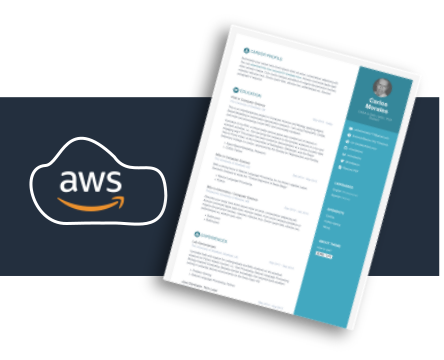
It is an experience-building activity aimed at presenting your resume using cloud technologies. It seems simple, right? Well, not quite. You are required to complete the tasks following best practices, which makes for a more dense project. The challenge consists of sixteen steps taking you through the learning journey of automating the full life cycle of a web application using cloud technologies. Of course, before reaching such automation, a manual process must already be in place.
Thus, you first learn to manually deliver your application to the cloud, in this case, a static website. Then, you make it publicly available through a custom domain name. And the whole task is completed by setting up every service needed yourself. Cloud technologies have simplified and reduced the cost of implementing this type of comprehensive project compared to doing the same on your hardware. However, weak spots exist in this version of the process due to the high human involvement required.
Fortunately, you can reduce those weaknesses by automating the manual process. So, you learn to do such automation. By doing that, you also gain experience in the best practices prevailing among cloud leaders. These allow them to quickly react to changes in user demand, to deliver software more often and with higher quality, and to anticipate and recover from failure faster. Thus, you have the chance to gain a solid set of skills.
If done correctly, the challenge takes you from zero to fluent in the cloud ecosystem of your choice within a few weeks.
What was my motivation for this challenge?
Not long ago, I stumbled upon a blog post describing how Amazon evolved their practices and tools until they successfully coped with the unprecedented surge in demand they observed on their first Black Friday sales.
The post in question was not a heavily-technical one providing a high-level overview of AWS and how their publicly available platform and knowledge base can power others to achieve similar features. Yet, this post solved many of the questions I had from my time in the industry.
For better or worst, my professional path revolved around early-stage start-ups (one of which was my own), highly interested in delivering software quickly but still adamant about adopting modern development practices. Thus, I experienced developing and deploying applications following mostly manual methods, and similarly, when executing operational activities, all done with no automation. Usually, the manual execution led to failures and sometimes even delaying the projects.
Thus, the post I mentioned gave me hope for a better way of doing software projects. That was exciting news! Therefore, I wanted to get involved as soon as possible. Yet, with no expertise or colleges working in this area, the chances of making this a reality looked grim.
Fortunately, this changed when I learned about this challenge! It seemed like an opportunity to dive into this area and increase my familiarity with the tools and techniques. Thus, I decided to tackle this project and opted to do so in AWS and here you will read my experience doing so.
My Experience
Tackling this project helped me realize the theoretical foundation gained preparing to sit the certifications was insufficient for this new task. But, I am always happy to learn new things and hone my skills.
Nevertheless, I had to fulfil the prerequisites before getting involved with the challenge,
Prerequisites
The certification, the challenge calls for the Cloud Practitioner certification, yet as I said earlier, I had already obtained the Solutions Architect and Developer certifications which I decided to use instead.
The resume, my resume needed to be a static website created only with internet-native technologies, such as Hypertext Mark-up Language (HTML) for the text and semantic content and Cascading Style Sheets (CSS) for the styling. Such a simple site may seem extremely basic, yet the technology stack needed for such a website is also greatly simplified. Given the complexity of the project I was about to tackle, this simplification was beneficial.
To my advantage, I was already using a static site generator to produce a personal blog which hosted an academic version of my resume. Thus, I devised a strategy to reuse parts of that site instead of creating one from scratch. For this, I took the last version of my site and branched from there, isolating the relevant content for the resume while the parent branch preserved the rest. After a few tweaks on both versions, I had the single repository ready and set up to produce the two sites needed. Being honest, I was not totally pleased by having both sites using the same layout and graphic design, but this had to do.
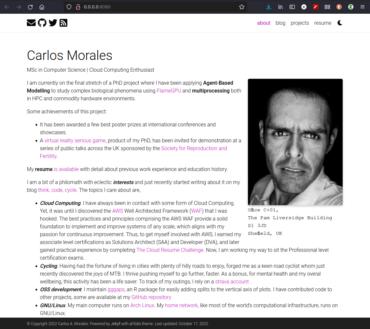
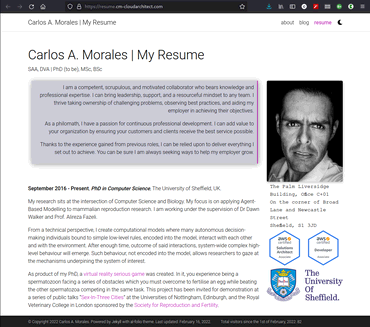
I later added a second statically generated site acting as a landing page for my resume. I am providing further detail near the end of the post.
Account setup, I already had an AWS account, so I did not create a new one for the challenge. Yet, I must touch on the security considerations I followed.
Firstly, I set up the root account with a secure password and 2FA, two-factor authentication, which transforms the standard login into a two-step process and requires the account owner to approve each login attempt via a physical device.
Secondly, I set up a budget with billing and usage alerts. This way, I would get prompt notification of unusual increases in usage.
For the challenge, I created two pairs of IAM users and roles in this account, each for specific tasks. The first one for executing administrative duties on the AWS console without programmatic access. The second one for developer-related activities with programmatic access to a subset of services. I also set up the latter for usage in the AWS CLI, which I had available on my local system since before the challenge.
Finally, I locked away the root account, which I did not use anymore during the project.

Securing a new or current account this way is crucial to prevent misuse, overcharges, and headaches. Plus, this is a first step towards the principle of least privilege which aims at reducing security exposure by providing just the right credentials for the activities to execute next.
Please note this post does not include any code, and I do not provide a detailed recap of how I solved the most challenging bits. I decided this to prevent diluting the experience for others taking the challenge. All my code is available in a private repository in my GitHub account. I can provide access upon request for legitimate purposes.
Stage 1, Manual labour
The first six steps of the challenge took me through the manual part of the process.
I started by uploading the resume site to an Amazon Simple Storage Service (S3) bucket with public website hosting enabled. Doing so makes the website available via an S3 website endpoint. Yet, the requirement calls for a custom domain name. Custom domain names must be set up with a DNS server, raising a new difficulty.
Routing traffic from a DNS server directly to an S3 bucket is impossible. Thus, I set up a CloudFront distribution, a Content Delivery Network providing fast access to your content from geographic regions distant from the physical location of the hardware hosting the website and acting as an intermediary between Route53 and S3.
Having my site hosted in the North-East region of the United States, any access from a different AWS region would face longer load times. Thankfully, the CloudFront distribution mitigated that by replicating the content to many servers to many servers across America and Europe. Thus, the website will load faster for anyone within these regions.
And, just like that, the website was now live!
Nevertheless, communication with a website should occur over an encrypted channel. This type of encryption requires a Transport Layer Security (TLS) certificate. In my case, AWS Certificate Manager produced the certificate for the website, and I only needed to set up CloudFront to use the certificate.
Completing these activities would have been enough for a website hosted on the AWS public cloud with encryption enabled. Yet, there was a lot more ground to cover in the challenge.
Usually, cloud applications interact with other services to improve the user experience. I needed to add a visitor counter and keep track of this number, meaning I needed to involve a programming language and a database. However, static site servers do not provide database access.
I learnt about DynamoDB, a fully-featured NoSQL database for the cloud. This type of database differs from the formerly most common SQL or relational databases in several aspects, the most relevant of which is the way they store data and how they represent relationships.
Regardless, accessing data from a database directly from the front end is not a good practice.
I needed to implement a database-enabled back-end service, so the website could interact with it to store and retrieve data. Usually, this means setting up a database server and configuring your application to access the resource. From previous experience, I was aware these activities were not trivial.
Luckily, serverless technologies abstract the details of building and running applications in the cloud. Thus, you can focus on implementing an application without worrying too much about the server side. Plus, in some cases, such as AWS Lambda Functions, they allow the application to be as minimal as a single function, which can have many benefits.
But AWS Lambda Functions cannot operate autonomously to handle the current scenario. They need a directory and routing service to receive and process the external requests and invokes the correct function based on the parameters it receives. API Gateway is the service that does this in AWS.
For implementing the functions enabling this interaction with DynamoDB, I took advantage of boto3, a Python framework from AWS exposing their services for easy consumption and integration. Doing so allowed me to easily and quickly complete the back-end application to enable the website to read and write data to and from the database.
However, following best practices, I must have thoroughly tested the Lambda functions before release. Thus, I added unit test to make sure the code was working correctly. This testing should be executed routinely as the code base changes to check the functionality covered still works as expected. At this point in the challenge, I was manually executing these tests.
After that, I set up API Gateway to invoke the Lambda functions in response to the requests coming from my website.
And that was all the work needed for the first part. It was a long and winding process, but I had a working site hosted on the AWS cloud accessible via a custom domain name. Plus, I had certainty the code was working, and future changes that may break the functionality would not get released if and only if I were to run the tests before updating the public website.
The infrastructure of my solution follows, providing a high-level overview of what services are involved and how they relate to each other.

The key takeaways for me from this first stage were,
- Securing and locking the
root accountis a MUST. -
IAMusers for the win! - NEVER embed credentials or secrets in code.
-
Origin-Access Identityis a more secure way of hosting a website onS3. - A standard
DNSserver cannot choose the best server to use per request based on specific rules, but other services, such asCloudFrontcan. - A
CloudFrontdistribution is a valid target for traffic from aDNSserver, and it can take anS3bucket as its origin. - Requests from
CloudFronttoS3areHTTP, notHTTPS.Amazon S3does not expose anHTTPSendpoint. - In some scenarios,
Lambdafunctions may needCORSheaders. - A
CloudFrontdistribution allows specifying domain name aliases to enable access to the cached content via custom domain names. - Always mind the delay between creating or updating a
CloudFrontdistribution and the files being ready at the edge locations.
Configuring all the services is a time-consuming activity, plus with so many details to set up, the surface of exposure is considerable. Let’s improve this.
Stage 2, Automation
To start this second part, I learnt to avoid manually configuring the API resources by leveraging the AWS Serverless Application Model (SAM) framework.
AWS SAM uses text-based templates to declare all the resources comprising a serverless application. These templates are part of a technology enabling the creation and provisioning of AWS infrastructure deployments predictably and repeatedly, also known as Infrastructure as Code (IaC). IaC intends to treat infrastructure the same way developers treat code. Among others, IaC enables versioning of the source template to keep track of the changes to the infrastructure as the projects evolve. Thus, from this point, I started using the Git system for this project and GitHub to host the remote code repository.
Now, that I was doing IaC, I was also executing part of the practices known as DevOps, short for development and operations. Other of these practices involve automating the integration and delivery pipeline. There are many tools available for these activities, such as AWS CodePipeline, or the more manual trio made of AWS CodeCommit, AWS CodeBuild, and AWS CodeDeploy, as well as non-AWS tools. I covered this part of the challenge using GitHub Actions. These are scripts running on GitHub servers and executing sequential tasks in response to code submissions. The GitHub Actions were responsible for running the unit tests and requiring all tests to pass before proceeding with the delivery of the AWS SAM template. Thus, this step added some certainty to my project in the remote case I submitted breaking changes.
However, the GitHub Actions needed programmatic access to the AWS resources in my account to complete their execution. I enabled this by creating a set of credentials in AWS IAM with restricted authorization for the services required. Provisioning credentials requires careful consideration due to the inherent security implications involved. It may be easy to hardcode the credentials directly in the code. However, this is a highly unsafe decision even when working with private repositories and goes against best practices. The safer option, and my course of action, is to use GitHub Actions secrets to store this sensitive data in encrypted storage and request the values from within the GitHub Actions.
For the next step, I focused my efforts on the front end. Thus, I created a second GitHub repository for the website and a new set of GitHub Actions. These GitHub Actions would synchronize the website files in Amazon S3 whenever a new commit changed the statically generated site in GitHub. In this case, I added a second task to invalidate the files in the CloudFront distribution cache after each update forcing an update from the new files in S3. Not doing so could have undesired consequences for my website.
At this point, I had almost completed the challenge. Yet, I was discontent with having my resume exposed directly without a landing page. So, I created a new version of the former landing page of my original static website and added another GitHub Action to the corresponding repository for publishing this landing page too.
Finally, I had the resume published on a subdomain and the landing page on the top-level domain.
This last step allowed me to experience more tools and techniques for hosting the website, distributing the content, monitoring, and cost optimizations beyond what the challenge required. More details are in the last section of the post.
And, just like that, I was done with the challenge, well, almost. The final activity was to write a post about this experience. Thus, this post was born.
The key takeaways for me from this second stage were,
-
AWS SAMis a subset ofCloudFormationand may be easier for some scenarios. -
AWS SAMandCloudFormationtemplates can directly deliver code to a target. - It is possible to embed code in
SAMandCloudFormationtemplates, but it is best to keep it short. - Targeting remote services for
Unit Testingcan quickly elevate costs. - Mocking services for testing prevents unnecessary delays and charges, among other things.
- I must aim for modular template designs that enable reuse.
- It is best to use
CloudFormationtemplate parameters instead of hard-coded values. - Stringent rules in the
CI/CDpipeline, such as enforced style checks, can help maintain code standards. - Failing to specify an alternate
CNAMEin aCloudFormationdistribution leads to403 errors. - Newly created certificates involve a manual validation step unless you automate the process.
- Having
CloudFormationgenerate new certificates without specifying a timeout for the template execution may lead to a never-ending process due to pt.10. - Taking care of the template runs is also taking care of the operational cost!.
The challenge is designed to provide sufficient experience to hit the ground running as a junior cloud engineer. However, given the wide spectrum of what is possible with cloud technologies, it is also possible to take the project as a starting point and execute further exploration according to your own interests.
Going beyond the requirements of the challenge
Given my interests and time constraints, I explored a couple of optimization strategies and a more secure way for hosting the static website. A brief of these follows,
A more secure way of hosting a static website in S3
I created an additional statically generated site to serve as the landing page for my resume. I also hosted this as a static site in S3, yet, instead of enabling Static website hosting, I set up an Origin-Access Identity in CloudFront. This feature enabled CloudFront to send authenticated requests to Amazon S3 and set S3 to allow access to authenticated requests from CloudFront only. This way, no S3 website endpoint is created either. Besides, this change also allowed me to explore using subdomains in Route53 to expose the resume site while preserving the top-level domain for the landing page.
Using subdomain-specific TLS certificates in CloudFront
TLS certificates encode information about the domain name they are validating, and they cannot change once they are issued. You must create a new certificate whenever changes are needed, such as updating some of its information. Thus, I needed to identify the simplest and most cost-effective option for updating the certificate that would better fit my scenario. For this, I also needed to consider each new certificate involves a manual authorization step in Route53.
I decided to use two certificates instead of only one. I linked the first certificate to the top-level domain and the second to the subdomains. This option was also a good fit for the independent CI/CD pipelines producing the static sites and the infrastructure of my solution.
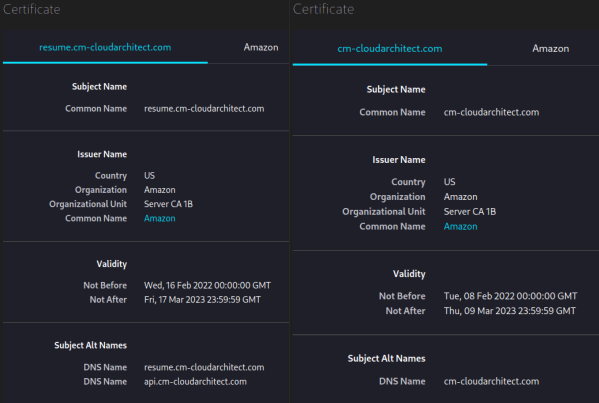
Optimizing operational costs
As the project evolved, I continuously did access and cost assessments to identify opportunities for optimization. Doing so was key after one of the last updates, where I introduced new templates for both static sites. The new templates increased the footprint of the static sites quite sharply, which triggered the alerts I set up.
After assessing the situation and identifying the culprits, I implemented a cost-reduction strategy via offloading resources to third-party CDNs and asset optimization.
Thus, achieving a reduction of the operational cost by 50%
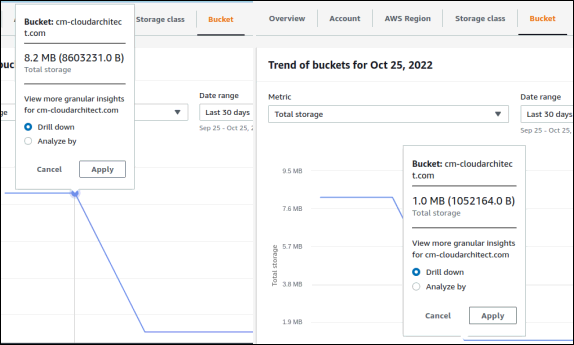
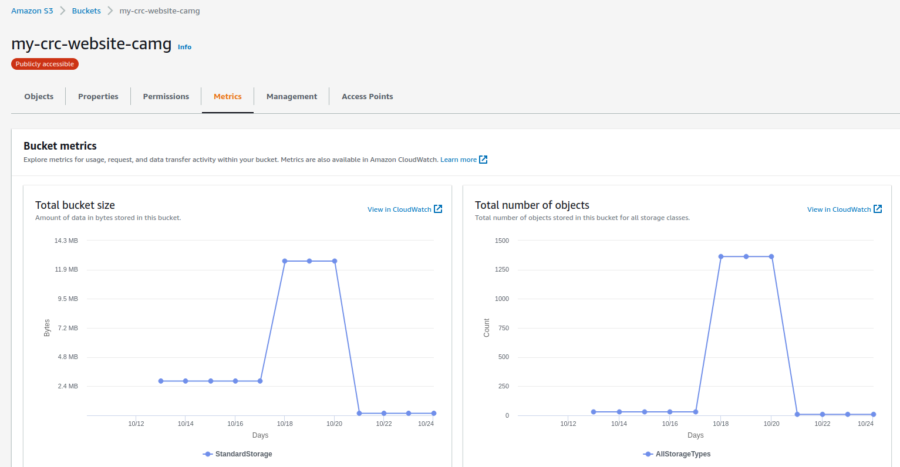
Closing words
Implementing the manual process was good as a learning exercise but distant from the best practices for cloud solutions. Applying IaC is not extremely difficult, and the gains far outweigh not doing so.
Automated infrastructure provisioning is the way of the cloud.
